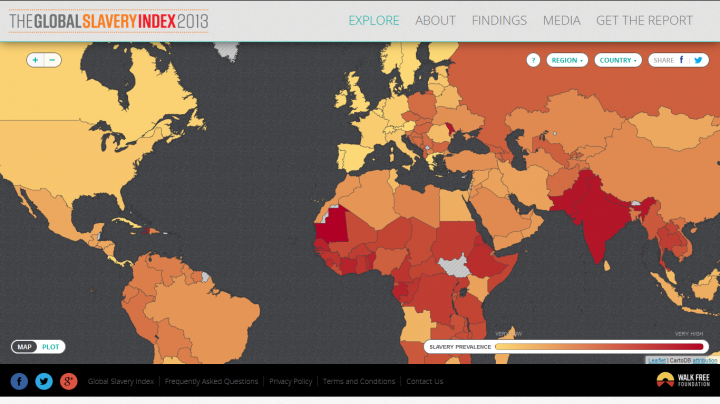
Modern slavery takes many forms and is known by a number of names such as slavery, forced labour and human trafficking. Whichever term is used, they all carry the same characteristic of an individual being deprived of their freedom by someone: their freedom to leave one job for another, their freedom to leave one workplace for another and their freedom to control their own body.
This year, the very first Global Slavery Index was published in an attempt to measure the scale of modern day slavery by ranking 162 countries and identifying risk factors for enslavement, as well as government responses. A general lack of information on the subject – such as who is being exploited and where – has long hindered anti-slavery campaigns and proved it near impossible to tackle the problem.
The Global Slavery Index is a product of the Walk Free Foundation, in consultation with experts from international organisations, think tanks and academic institutions.
Estimated number of population in modern slavery
The report found that 76% of the total number of slaves in the world live in only ten countries – India, China, Pakistan, Nigeria, Ethiopia, Russia, Thailand, Democratic Republic of Congo, Myanmar and Bangladesh.
The country with the largest estimated number of people in slavery is India, with a staggering 13 – 15 million (approx.) people enslaved. The research suggested that there is some exploitation of foreign nationals within India. However, the largest proportion of this problem is the exploitation of Indian citizens themselves, mostly through debt bondage and bonded labour.
On the other end of the spectrum are Iceland, Ireland and the UK, with a tied ranking of 160 out of 162 countries. This does not mean that these countries are slavery free. It is estimated that as many as 4,200 – 4,600 people are enslaved in the UK and 300 – 400 in Ireland.
According to the Ireland country report, Ireland is used as a ‘source’ and ‘transit’ country for victims of trafficking for sexual exploitation, forced labour and forced criminal activity.
“There have also been cases of children being sexually exploited and exploited through domestic servitude, benefit fraud, sweatshop or restaurant work, illegal removal of organs, illegal adoption, forced begging and pickpocketing.”
Most Notable Aspects in Ireland
According to government statistics in Ireland, the majority of victims have been women who have been trafficked for sexual exploitation. Women have also been found to be working in conditions of modern slavery as domestic workers, particularly in the homes of foreign diplomats.
What Needs to Happen:
The report outlines the actions the government is taking to prevent and address the issue of modern day slavery. However, it also lists what needs to happen and what Ireland should do. For the full details on this, see the Ireland Country Report.
On the Walk Free Foundation website, there is a wealth of information on this issue of modern slavery including country reports, regional information and an interactive map presenting different stats for each country.
_______________________________
Explore more…
- Walk Free Foundation | The WFW mission is to end modern slavery in our generation by mobilising a global activist movement, generating the highest quality research, enlisting business and raising unprecedented levels of capital to drive change in those countries and industries bearing the greatest responsibility for slavery today | https://walkfreefoundation.org
- Follow the Global Slavery Index on Twitter | https://twitter.com/SlaveryIndex
Useful blogs on slavery on DevelopmentEducation.ie
- Exploring modern slavery: a teacher’s perspective by Clifton Rooney | 9th May 2013
- TY Students from Bray use art to investigate contemporary slavery by Patryk Labuzek, Andrew Dore and Conor Davenport | 21st March 2013
- How to teach…slavery by Ciara Regan | 22 August 2012
- Campaigners can still learn from the Abolition of Slavery by Tony Daly | 29th March 2012
